Switching careers is exciting—but it can also feel intimidating. Recruiters often wonder: “Why is this person moving from one field to another? Do they really have the skills we need?” That’s where a powerful cover letter comes in. Unlike your resume, which lists jobs and dates, your cover letter gives you the space to explain your transition story, highlight transferable skills, and show genuine motivation for entering a new field.
A well-crafted career change cover letter bridges the gap between your past experience and your future goals. It reassures hiring managers that while your job title may be different, your skills—like leadership, problem-solving, communication, or data analysis—remain highly relevant.
In this article, you’ll learn:
- Realistic, full cover letter examples tailored to popular career changes (technology, sustainability, healthcare, logistics).
- How to write each section of a career change cover letter (header, greeting, introduction, body, and closing).
- Formatting rules that make your letter professional and ATS-friendly.
- Common mistakes career changers make—and how to avoid them.
- A sample career change resume that complements your cover letter.
- Clear answers to FAQs recruiters often have about career change cover letters.
By the end, you’ll not only understand the structure of a strong letter but also see real examples you can adapt immediately. Let’s start with the part most readers come here for—cover letter examples that work in real hiring situations.
Cover Letters For Career Change
- Teacher to Data Analyst Career Change Cover Letter
- Career Change to Renewable Energy Cover Letter
- Customer Service to IT Support Career Change Cover Letter
- Career Change to Healthcare Cover Letter
- Accountant to Data Analyst Career Change Cover Letter
- Career Change to Supply Chain Cover Letter
Cover Letter Template For Career Change From Teacher to Data Analyst
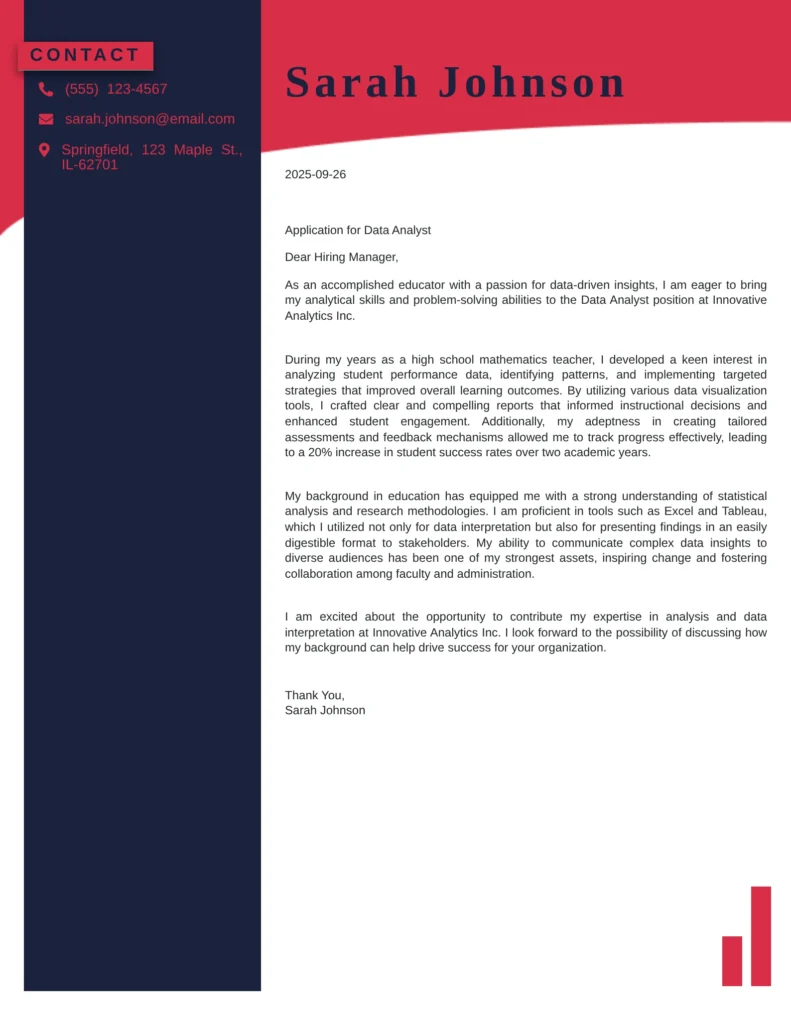
Why This Cover Letter Is Good:
This cover letter effectively connects the applicant’s educational background to the data analysis role, emphasizing transferable skills and concrete achievements. It makes a strong case for why the applicant would be a valuable asset to the company.
Teacher to Data Analyst Career Career Change Cover Letter | Text Sample
Laura Bennett
laura.bennett@email.com | 555-456-7890 | Denver, CO
Date
Hiring Manager
[Company Name]
Dear Hiring Manager,
I am excited to apply for the Data Analyst position at [Company Name]. With several years of experience as a teacher, I have honed analytical, research, and communication skills that I am eager to transfer into the field of data analytics. While my background is in education, I have recently completed coursework in SQL, Excel, and Python, and I am ready to bring both my technical training and my problem-solving mindset to your team.
As a teacher, I regularly collected and analyzed student performance data to track progress and adjust lesson plans. I designed assessments, identified trends, and presented insights to parents and colleagues to improve student outcomes. This experience mirrors the responsibilities of a data analyst—translating raw information into actionable insights.
I am drawn to [Company Name] because of your reputation for leveraging data to drive innovation. I am confident that my ability to break down complex information and communicate findings clearly will allow me to make a meaningful contribution to your organization.
Thank you for your time and consideration. I would welcome the opportunity to discuss how my skills and recent training align with your data analytics needs.
Sincerely,
Laura Bennett
Why This Cover Letter Is Good:
- Bridges education background with data responsibilities.
- Highlights transferable skills (analysis, communication, presenting insights).
- Mentions upskilling in relevant tools (SQL, Excel, Python).
- Shows genuine career change motivation + company alignment.
Cover Letter Template For Career Change to Renewable Energy / Clean / Sustainability
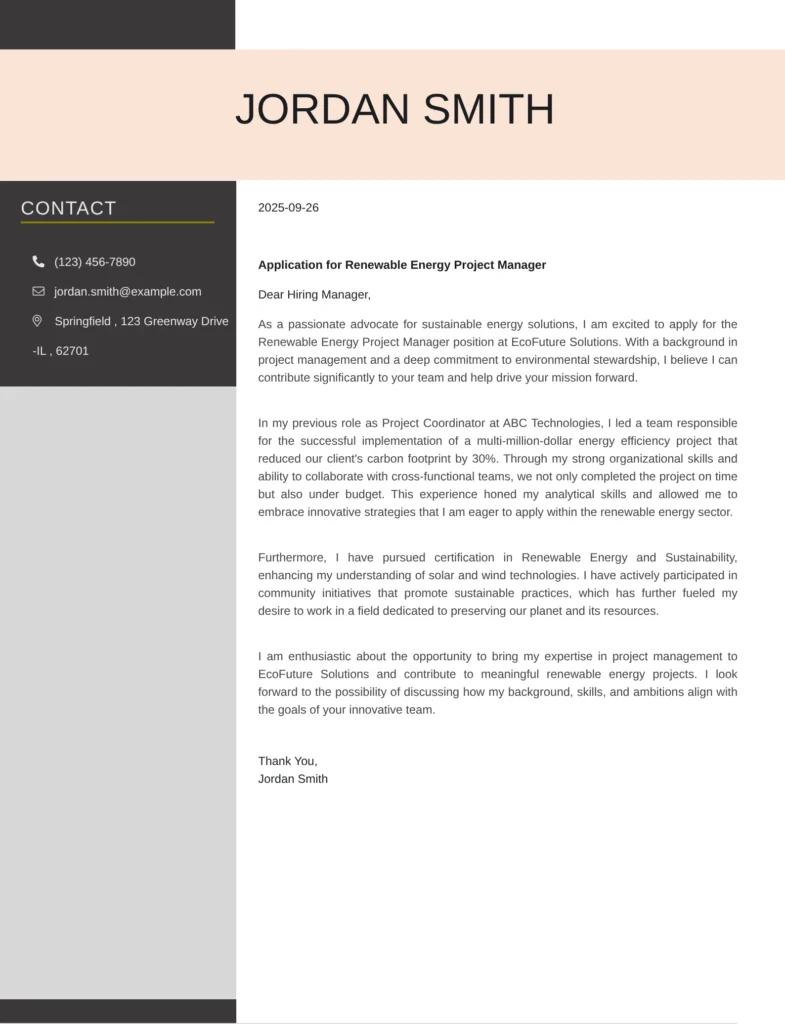
Why this cover letter is good:
This cover letter effectively highlights the applicant’s transferable skills and specific achievements relevant to the renewable energy field. It demonstrates passion for sustainability while outlining real-world experiences that showcase relevant capabilities, making a strong case for the applicant’s fit for the position.
Customer Service to IT Support Career Change Cover Letter

Why This Cover Letter Is Good:
This cover letter effectively connects the candidate’s customer service experience to the IT support role, showcasing transferable skills and a proactive approach to learning. It includes a concrete achievement that demonstrates capability, making a strong case for the candidate’s suitability for the position.
Cover Letter For Career Change From Customer Service to IT Support | Text Sample
David Thompson
david.thompson@email.com | 555-123-4567 | Atlanta, GA
Date
Hiring Manager
[Company Name]
Dear Hiring Manager,
I am writing to express my interest in the IT Support Specialist position at [Company Name]. With several years of customer service experience, I bring a strong background in troubleshooting, communication, and problem-solving. Recently, I have completed IT fundamentals training, and I am eager to transition my career into technology where I can combine my technical knowledge with my proven ability to support people effectively.
In my customer service role, I frequently assisted clients with resolving issues, guiding them through step-by-step solutions, and ensuring their satisfaction. This required patience, clear communication, and the ability to stay calm under pressure—skills that are equally vital in IT support. I have also gained hands-on technical knowledge through CompTIA A+ training and setting up systems for personal projects.
I am particularly impressed by [Company Name]’s commitment to delivering exceptional technical support and innovation. I would welcome the opportunity to apply my customer-focused approach and growing technical expertise to help your team provide excellent IT service.
Thank you for considering my application. I look forward to the chance to discuss how my background and training can benefit your organization.
Sincerely,
David Thompson
Why This Cover Letter Example Is Good:
- Directly ties customer service problem-solving to IT troubleshooting.
- Balances new technical training with proven people skills.
- Demonstrates ability to remain calm under pressure.
- Aligns career pivot with company’s service-oriented values.
Cover Letter Template For Career Change to Healthcare / Care Economy
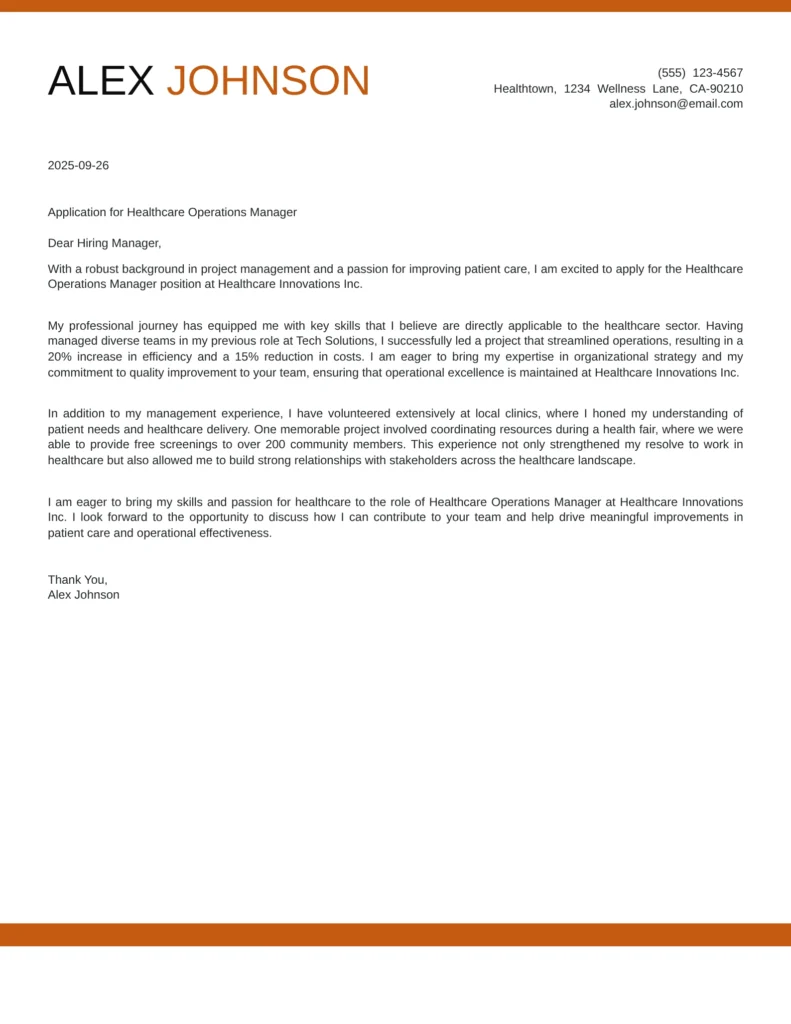
Why This Cover Letter Is Good:
This cover letter is effective because it clearly connects the applicant’s past experiences to the new role they wish to pursue. It provides specific examples of achievements, showcases a commitment to healthcare through volunteer work, and ends with a positive, action-oriented closing that invites further dialogue.
It’s important to leave your current job without burning bridges. Learn how to resign gracefully from a position in the hospital or healthcare industry.
Accountant to Data Analyst Career Change Cover Letter
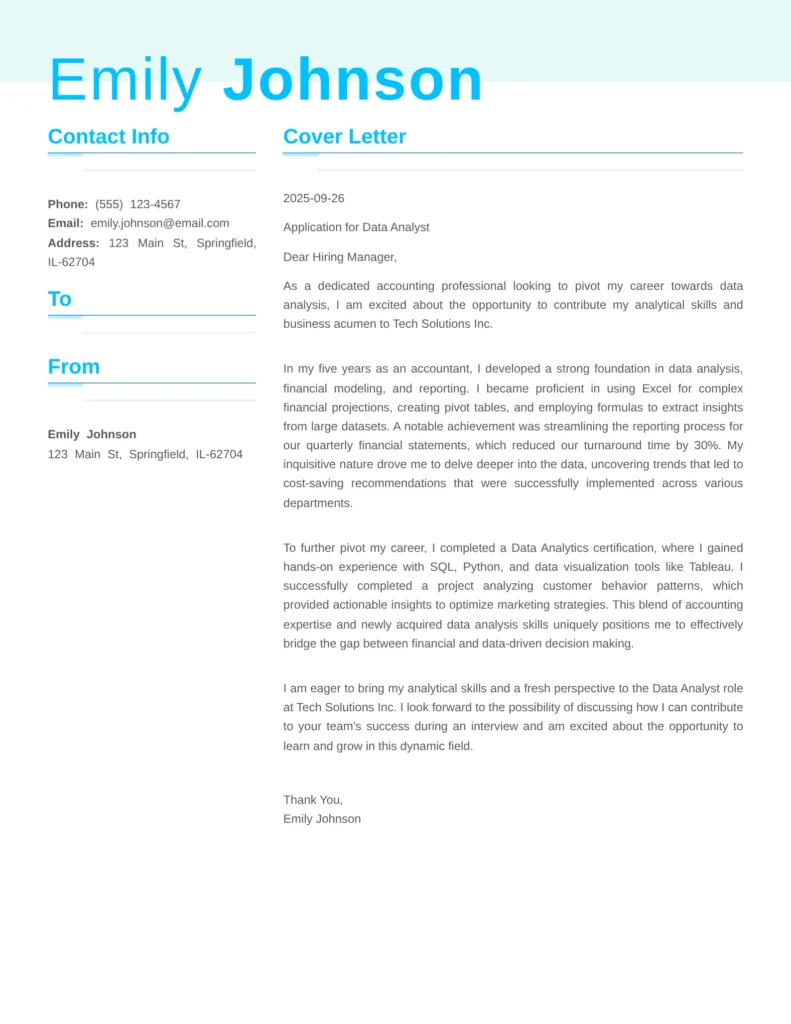
Why This Cover Letter Is Good:
This cover letter effectively showcases Emily’s transferable skills, relevant achievements from her accounting background, and her commitment to transitioning into data analysis. It emphasizes her proactive learning and determination, making a strong case for her candidacy.
Cover Letter For Career Change From Accountant to Data Analyst | Text Sample
Michelle Nguyen
michelle.nguyen@email.com | 555-789-6543 | San Francisco, CA
Date
Hiring Manager
[Company Name]
Dear Hiring Manager,
I am excited to apply for the Data Analyst role at [Company Name]. As an accountant with over five years of experience in financial reporting and analysis, I have developed advanced skills in Excel, data validation, and identifying trends in large datasets. I am now eager to pivot my career toward data analytics, where I can apply my quantitative skills and passion for problem-solving to broader business challenges.
In my accounting role, I regularly built financial models, analyzed budgets, and presented reports to senior leadership. I also streamlined reporting processes by automating data entry tasks with Excel formulas, which reduced errors and saved time for the finance team. Recently, I have expanded my technical skills through coursework in SQL and Tableau, further preparing me to contribute in a data-driven role.
I admire [Company Name] for your commitment to using data to drive business decisions. I am confident that my financial background, combined with my technical training, will allow me to provide valuable insights and support data-driven strategies.
Thank you for your consideration. I look forward to the opportunity to discuss how my background in finance and my new skills in analytics align with your needs.
Sincerely,
Michelle Nguyen
Why This Cover Letter Example Is Good:
- Translates accounting experience into analytics context.
- Shows quantitative skills + Excel mastery as transferable.
- Mentions upskilling in SQL and Tableau.
- Clear career pivot but framed as logical and relevant.
Cover Letter Template For Career Change to Supply Chain / Logistics / Operations
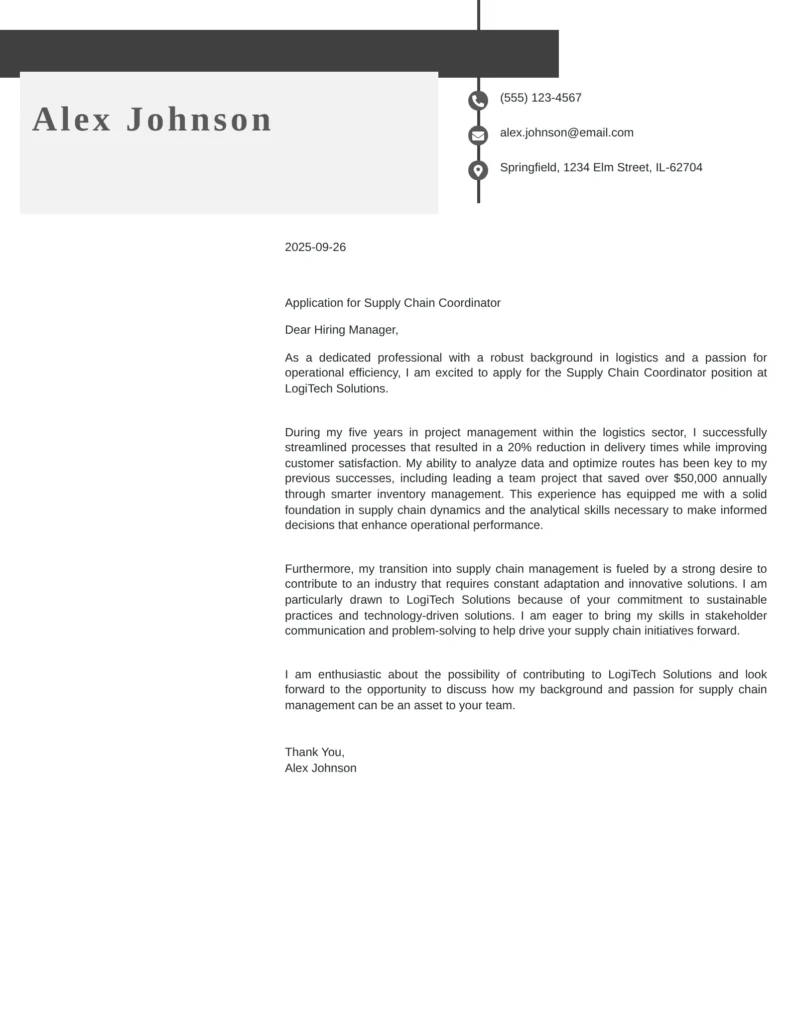
Why This Cover Letter Is Good:
This cover letter effectively conveys the applicant’s relevant experience and enthusiasm for the role while clearly connecting their previous achievements to the needs of the company. It is targeted, persuasive, and maintains a professional tone throughout.
How to Write a Career Change Cover Letter
A career change cover letter isn’t about apologizing for your past career — it’s about connecting the dots between what you’ve done and what you want to do next. The structure is the same as any other cover letter, but the emphasis is on transferable skills, motivation, and proof you can adapt quickly. Here’s how to build each section.
Header
Keep it professional and aligned with your resume. Use your full name, phone, email, LinkedIn, and the date. Beneath that, add the hiring manager’s name, title, company, and address.
Example:
Jordan Reyes
(555) 123-4567 | jordan.reyes@email.com | LinkedIn.com/in/jordanreyes
March 5, 2025
Ms. Anita Patel
Hiring Manager
GreenTech Solutions
1234 Innovation Drive
Austin, TX 73301
Greeting
Always address the hiring manager by name if you can find it. If not, “Dear Hiring Manager” works fine.
Examples:
- Dear Ms. Patel,
- Dear Hiring Manager,
Introduction
Your first few lines need to explain two things: why you’re excited about the new field and how your background makes sense for it. Show the bridge right away.
Examples:
- I am excited to apply for the Data Analyst position at TechNova, where I can combine my background in financial reporting with a strong interest in data-driven decision-making.
- After five years in hospitality management, I am eager to bring my leadership and customer service experience into the healthcare sector, where empathy and organization are equally vital.
Body Paragraph(s)
Here you prove that your past achievements are directly relevant. Focus on skills that transfer naturally: communication, project management, problem-solving, analysis, leadership. Use concrete examples and measurable results.
Examples:
- As a retail supervisor, I analyzed weekly sales reports to identify patterns and improve performance. That same analytical skill will help me interpret patient-care data and improve operational outcomes in healthcare.
- Managing a logistics team taught me how to streamline processes and reduce costs by 15%. I see those same process-improvement skills aligning closely with supply chain optimization at your company.
- Beyond technical strengths, I bring adaptability and the ability to learn quickly — qualities that have allowed me to succeed each time I’ve stepped into new challenges.
Closing
End confidently. Reinforce your enthusiasm for the career shift and invite them to connect.
Examples:
- I would welcome the opportunity to discuss how my background in education and my new certification in instructional design can add value to your L&D team.
- Thank you for considering my application. I am excited about the chance to bring my transferable skills and passion for renewable energy to GreenTech Solutions.
Pro Tips for Career Change Cover Letters
- Tailor each letter. Show a clear link between your old and new career — don’t just copy-paste.
- Use numbers. Measurable results (increased sales by 20%, reduced costs by $50K) prove your impact.
- Stay positive. Frame your change as growth, not as running away from something.
- Mention learning. Highlight certifications, online courses, or projects that bridge your career shift.
- Keep it tight. Three to four paragraphs on one page is enough.
- Templates are fine — but customize. A generic template without tailoring does more harm than good.
Career Change From military to Civilian Jobs
The examples below highlight strong resumes for professionals transitioning from military to civilian careers. A military resume demonstrates your discipline, leadership, and adaptability, while also showcasing how the skills you gained in service can be applied to succeed in civilian roles.
Resume For Career Change from Military
John Anderson
555-123-4567 | john.anderson@email.com | Denver, CO | LinkedIn: linkedin.com/in/johnanderson
Professional Summary
Dedicated and adaptable U.S. Army veteran with 8+ years of leadership, operations, and logistics experience, transitioning into civilian workforce. Proven ability to manage teams, oversee complex projects, and deliver results under pressure. Skilled in communication, problem-solving, and process improvement. Actively pursuing opportunities in operations management, project coordination, and security roles.
Key Skills
- Team Leadership & Training
- Project & Operations Management
- Security & Risk Assessment
- Process Improvement
- Communication & Collaboration
- Logistics & Supply Chain Coordination
- Technical Troubleshooting
- Adaptability & Decision-Making
Professional Experience
U.S. Army – Various Locations
Operations Specialist / Team Leader
2015 – 2023
- Supervised and trained teams of up to 20 personnel in high-pressure environments, ensuring mission readiness and compliance with procedures.
- Coordinated logistics for supply distribution across multiple units, improving efficiency by 15%.
- Managed daily operations, scheduling, and resource allocation to support mission-critical activities.
- Led risk assessments and implemented safety protocols that reduced incidents by 25%.
- Recognized with Army Achievement Medal for exceptional leadership during overseas deployment.
Education
Bachelor of Science in Business Administration
University of Maryland Global Campus — 2023
Certifications
- Project Management Professional (PMP) – In Progress
- OSHA Safety Certification
- CompTIA Security+
Additional Information
- Security Clearance: Secret (Active)
- Volunteer: Mentor for Veterans Transition Network, supporting service members entering civilian careers
Cover Letter for Career Change from Military
John Anderson
555-123-4567 | john.anderson@email.com | Denver, CO | LinkedIn: linkedin.com/in/johnanderson
Date
Hiring Manager
[Company Name]
[Company Address]
[City, State, Zip]
Dear Hiring Manager,
I am writing to express my interest in the [Job Title] position at [Company Name]. As a U.S. Army veteran with over eight years of experience in leadership, operations, and logistics, I am eager to bring my discipline, problem-solving ability, and team management skills into a civilian role where I can continue making a positive impact.
During my military service, I led teams of up to 20 personnel, managed mission-critical operations, and coordinated logistics across multiple locations. These responsibilities required adaptability, attention to detail, and strong communication skills—all of which directly align with the demands of civilian roles such as operations management, project coordination, and security. For example, I streamlined supply distribution processes that improved efficiency by 15% and received the Army Achievement Medal for outstanding leadership in high-pressure environments.
I am particularly drawn to [Company Name] because of your reputation for [insert company value or initiative, e.g., innovation, commitment to excellence, or support for veterans]. I am confident that my proven ability to lead teams, manage complex projects, and ensure operational success will allow me to contribute meaningfully to your organization.
Thank you for considering my application. I would be honored to discuss how my background, skills, and dedication can support the success of your team.
Sincerely,
John Anderson
How to Format a Career Change Cover Letter
Even the best story can be overlooked if your cover letter looks messy. Formatting is especially important for career changers because you’re already asking the employer to take a chance on you — your letter should show polish, professionalism, and attention to detail.
Formatting Rules
- Font: Use a clean, professional font like Calibri, Arial, or Times New Roman.
- Font Size: 11–12 points for the body, 14–16 points for your name in the header.
- Margins: Keep 1-inch margins on all sides for readability.
- Spacing: Use single spacing within paragraphs and one blank line between sections.
- Alignment: Left-align everything; avoid justified text that can create odd spacing.
- Length: Stick to one page, ideally 3–4 short paragraphs.
- File Type: Save as PDF unless the job posting specifically asks for Word. PDFs preserve your formatting.
- Consistency: Match the style and header design of your resume for a unified look.
Common Mistakes Career Changers Make in Cover Letters — and How to Fix Them
Switching careers is already a big leap. Your cover letter should convince a recruiter that the leap makes sense. Unfortunately, many career changers fall into patterns that hurt their chances. Below are the most damaging mistakes — paired with smarter alternatives you can use right away.
Mistake 1: Repeating Old Job Descriptions Without Translation
A frequent misstep is to copy-paste duties from your past role as if the recruiter will “connect the dots.” They won’t. You must do the translation yourself.
🔴 Weak:
“Responsible for supervising a team of 12 retail associates and handling inventory.”
🟢 Stronger (translated):
“Led a 12-person team and streamlined inventory processes, skills I now bring to supply chain coordination where efficiency and team leadership are crucial.”
Pro Tip: Frame your past duties in the language of your new career.
Mistake 2: Sounding Defensive About the Career Change
Applicants often start with apologies: “Although I don’t have direct experience…”. This creates doubt from the first line.
🔴 Weak:
“I don’t have experience in data analytics, but I am willing to learn.”
🟢 Stronger (confident):
“My experience analyzing financial reports gives me a solid foundation for data analytics, and I’ve strengthened this through a recent Google Data Analytics certification.”
Pro Tip: Never apologize. Lead with strengths, not gaps.
Mistake 3: Using Vague, Generic Skills Without Evidence
Hiring managers glaze over when they see “hard worker,” “fast learner,” or “team player.” These phrases mean nothing unless tied to proof.
🔴 Weak:
“I am a quick learner who adapts well.”
🟢 Stronger (with proof):
“Within two months of joining my last role, I mastered a new CRM system and trained a team of five, showing my ability to learn quickly and transfer knowledge effectively.”
Pro Tip: Always back up soft skills with specific achievements.
Mistake 4: Overexplaining the Backstory
Career changers sometimes feel they must tell their entire journey — why they picked the old career, why they’re leaving, personal stories, and so on. This overwhelms the reader.
🔴 Weak:
“After completing my degree in history, I worked for five years in teaching but always dreamed of technology. Growing up, I was fascinated by computers, and in college I often fixed laptops for friends…”
🟢 Stronger (focused):
“After five years in education, I’ve shifted to technology by completing a coding bootcamp and building three web applications that showcase my problem-solving and adaptability.”
Pro Tip: Keep the focus on skills and relevance, not autobiography.
Mistake 5: Sending a Template Letter That Feels Lifeless
Generic templates are easy to spot — the kind that could be sent to any company. For career changers, that’s deadly because the recruiter already needs reassurance.
🔴 Weak:
“I am excited to apply for the open position at your company. I believe my skills make me a good fit.”
🟢 Stronger (personalized):
“Your company’s focus on sustainable supply chains aligns with my own experience in logistics and my passion for building greener business practices.”
Pro Tip: Show that you’ve researched the company and know why this role is the right fit for your career shift.
Mistake 6: Using the Wrong Tone — Either Too Formal or Too Casual
Tone is a hidden deal-breaker. Some career changers overcompensate by writing in stiff, overly formal language that feels lifeless. Others go too casual, trying to sound “relatable” but coming off unprofessional.
🔴 Weak (too formal):
“I humbly submit my candidacy for your esteemed organization and sincerely beseech your consideration.”
🔴 Weak (too casual):
“Hey there, I’ve always wanted to try out this field and figured I’d give it a shot!”
🟢 Balanced (professional + approachable):
“I am excited to apply for the Product Manager role at Horizon Apps, where I can combine my background in IT support with a passion for building user-focused solutions.”
Note: Aim for confident, professional, and conversational — not robotic or chatty.
Mistake 7: Ignoring Certifications or Training That Bridge the Gap
Many career changers invest time in courses, workshops, or certifications, but then fail to mention them in the cover letter. That’s a missed opportunity to prove commitment.
🔴 Weak:
“I am looking to transition into data analytics.”
🟢 Stronger (with evidence):
“I am transitioning into data analytics and recently completed the Google Data Analytics Certificate, where I built dashboards and worked on real-world datasets.”
Note: Always highlight learning efforts — it shows you’re not just curious but prepared.
Career Change Resume Example | Text Sample
Here’s a sample resume designed for someone moving from hospitality management into healthcare administration. Notice how the experience is reframed to highlight transferable skills like leadership, organization, and communication.
Jordan Reyes
(555) 123-4567 | jordan.reyes@email.com | LinkedIn.com/in/jordanreyes | Austin, TX
Summary
Adaptable professional with 7+ years of leadership in hospitality management, now transitioning into healthcare administration. Skilled in team leadership, process optimization, and delivering exceptional client experiences. Recently completed a Healthcare Administration Certificate, equipping me with knowledge of compliance, patient services, and medical office operations.
Key Skills
- Staff Leadership & Training
- Scheduling & Resource Allocation
- Process Improvement
- Patient-Centered Service
- Data Entry & Records Management
- Conflict Resolution
- MS Office Suite | EHR Systems (Cerner – in training)
Professional Experience
Hospitality Manager
Sunrise Hotels & Resorts — Austin, TX
2017 – 2024
- Directed daily operations for a 120-room property, supervising a team of 25 staff and maintaining a 95% customer satisfaction rating.
- Implemented a digital scheduling system that cut staff conflicts by 40% — a process improvement skill transferable to patient scheduling in healthcare.
- Trained new employees on compliance and service standards, mirroring the onboarding and policy training required in healthcare settings.
- Handled guest complaints with empathy and professionalism, ensuring positive outcomes — a foundation for patient-focused service.
Assistant Front Office Manager
Hillcrest Inn — Austin, TX
2014 – 2017
- Coordinated check-in operations for 200+ guests daily, balancing accuracy with speed — relevant to managing patient intake and records.
- Managed confidential guest data with discretion, a responsibility parallel to HIPAA requirements in healthcare.
- Recognized with “Manager of the Quarter” award for problem-solving and service excellence.
Education & Certifications
- Healthcare Administration Certificate — University of Texas Online (2024)
- B.A. in Communications — University of Houston (2014)
Why This Resume Example For Career Change Is Good:
- Transferable skills are highlighted clearly. The resume doesn’t just list hospitality tasks; it reframes them into healthcare-relevant strengths (e.g., scheduling → patient intake, service standards → compliance training).
- Certifications bridge the gap. The Healthcare Administration Certificate proves commitment and makes the transition believable.
- Results are quantified. Metrics like “cut staff conflicts by 40%” and “95% satisfaction rating” show measurable impact, which builds credibility in any industry.
- ATS-friendly structure. Sections like “Key Skills” and consistent formatting make it easy for recruiters and applicant tracking systems to scan for relevant keywords.
Resume Tips for Career Changers
- Lead with a strong summary. Make it clear you’re changing careers but emphasize transferable strengths.
- Reframe old experience. Translate duties into skills that fit your new industry.
- Highlight learning efforts. Certifications, online courses, or workshops show commitment.
- Use a consistent format. Keep fonts, margins, and spacing identical to your cover letter.
- Quantify achievements. Numbers cut through doubt — whether in sales, operations, or healthcare.
- Add a “Key Skills” section. This helps ATS scan for relevant keywords.
Conclusion: Framing Your Career Change the Right Way
Changing careers can feel like standing at the edge of a cliff — exciting but uncertain. The right cover letter turns that uncertainty into confidence, showing employers that you’re not “starting from scratch” but bringing valuable experience, fresh perspective, and proven skills into a new field.
Remember: your cover letter is not just about explaining the past; it’s about framing your future. With clear transferable skills, a strong structure, and a confident tone, you can make any hiring manager see the logic behind your move.
To maximize your chances, always pair your letter with a career-change-focused resume that highlights relevant skills, reframes old experiences, and showcases any certifications or training you’ve added. Together, these two documents give a recruiter every reason to say yes.
Read More :- Short Cover Letter For Email Applications
FAQs(People Also Asked)
Open with a clear “why now” plus the value you bring, then translate past wins into the target role’s language. Use a tight structure: 1) motivation + fit, 2) 2–3 quantified achievements reframed for the new field, 3) proof of upskilling (certs, projects), 4) confident close. Mini-template you can adapt: “I’m transitioning from [old field] to [new field] to apply my strengths in [transferable skill 1, 2]. In my last role, I [achievement + metric], experience I’ll use to [target outcome]. I’ve completed [course/cert/project], and I’m excited to contribute to [company initiative].”
Prioritize skills that map cleanly to the job description: communication, stakeholder management, project coordination, problem-solving, data literacy, service excellence, process improvement. Make each skill tangible with a metric or scenario: “Reduced scheduling conflicts 40%,” “Onboarded 15 staff to new SOPs,” “Consolidated reports for leadership decisions.”
1. Technology / Data / AI: data analysis, SQL/Excel literacy, experimentation mindset, documentation, stakeholder communication, agile teamwork.
2. Renewable Energy / Sustainability: project coordination, compliance/reporting, vendor management, cost/reduction tracking, policy/process rollouts.
3. Healthcare / Care Economy: empathy, de-escalation, scheduling/throughput, accuracy in records, cross-functional coordination, confidentiality.
4. Supply Chain / Logistics / Operations: inventory control, process mapping, KPI tracking (OTIF, lead time), vendor relations, cost optimization.
Back each with proof: “Cut lead time 12% by redesigning pick-paths,” “Logged zero PHI breaches across 2 years.”
Mention it briefly, then translate it. One line to establish context, then move immediately to relevance and results. Example: “After five years in hospitality, I’m pivoting to healthcare administration—bringing team leadership, conflict resolution, and scheduling discipline that improve patient flow.”
Aim for 250–400 words (3–4 compact paragraphs). Use one high-signal example per paragraph rather than a long backstory. Short sentences, strong verbs, and numbers (%, $, time saved) outperform generic claims in both human scans and AI summaries.
Use a combination (hybrid) resume: Summary with target keywords → Key Skills aligned to the job ad → Experience reframed for relevance → Education/Certifications. Keep achievements metric-driven and role-relevant. Avoid pure “functional” formats (can look evasive to recruiters and ATS).
Show evidence of momentum: recent certifications (e.g., Google Data Analytics, CAPM), portfolio projects, volunteer/bridge roles, internships, shadowing. Translate one or two prior wins into the target KPI. Example: “Analyzed sales data weekly to guide inventory; I’ll apply the same methods to reduce stockouts in your DC network.”
Yes—as a starting point only. Templates keep structure clean; AI can brainstorm phrasing. Then humanize: insert your metrics, name the company’s product/mission, mirror 6–8 keywords from the job ad, and cut anything that sounds generic. Save as PDF unless .docx is requested to preserve formatting.
Use this plug-and-play opener and customize the bracketed parts:
“I’m applying for the [role] at [company] to bring my background in [old field]—especially [transferable skill 1] and [transferable skill 2]—to [target business outcome]. In my last role, I [achievement + metric], experience I’ll apply to [specific team/initiative at company]. I’ve recently completed [relevant cert/project], underscoring my commitment to this transition.”








